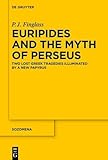Euripides and the Myth of Perseus : Two Lost Greek Tragedies Illuminated by a New Papyrus / Patrick Finglass.
Material type: TextSeries: Sozomena : Studies in the Recovery of Ancient Texts ; 21Publisher: Berlin ; Boston : De Gruyter, [2024]Copyright date: 2024Description: 1 online resource (XIV, 167 p.)Content type:
TextSeries: Sozomena : Studies in the Recovery of Ancient Texts ; 21Publisher: Berlin ; Boston : De Gruyter, [2024]Copyright date: 2024Description: 1 online resource (XIV, 167 p.)Content type: - 9783111381695
- 9783111384313
- 9783111384146
- 930
- online - DeGruyter
- Issued also in print.
| Item type | Current library | Call number | URL | Status | Notes | Barcode | |
|---|---|---|---|---|---|---|---|
 eBook
eBook
|
Biblioteca "Angelicum" Pont. Univ. S.Tommaso d'Aquino Nuvola online | online - DeGruyter (Browse shelf(Opens below)) | Online access | Not for loan (Accesso limitato) | Accesso per gli utenti autorizzati / Access for authorized users | (dgr)9783111384146 |
Browsing Biblioteca "Angelicum" Pont. Univ. S.Tommaso d'Aquino shelves, Shelving location: Nuvola online Close shelf browser (Hides shelf browser)
Frontmatter -- Contents -- Preface -- Abbreviations -- List of Figures, Tables and Papyrological symbols -- Introduction -- 1 The Perseus Myth in Archaic and Classical Greece -- 2 Dictys and Danaë: Before the Hypotheses -- 3 The Hypotheses of P.Oxy. 5283 -- 4 Dictys and Danaë: In the Light of the Hypotheses -- 5 Euripides’ Tetralogy of 431 bc -- 6 A Rhetorical Context? -- Bibliography -- Index
restricted access online access with authorization star
http://purl.org/coar/access_right/c_16ec
A recently-published second-century papyrus, P.Oxy. 5283, contains prose summaries (hypotheses) of six plays by the Greek dramatist Euripides, including two lost plays depicting the hero Perseus, Dictys and Danaë. This book demonstrates the significance of this discovery for our understanding of Greek tragedy. After setting out the mythological and dramatic context, and offering a new text and translation based on autopsy, the book analyses the light which the papyrus sheds on these plays, whose narratives, centred on female resistance to abusive male tyrants, speak as powerfully to us today as they did to their original audiences. It then investigates Euripides’ tragic trilogy of 431 BC, which ended with Dictys and began with Medea, whose dramatic power now stands in sharper focus given our improved understanding of the production in which it originally appeared. Finally, it ponders the purpose which these hypotheses served, and why readers in the second century AD should have wanted a summary of plays written more than half a millennium before. All Greek (and Latin) is translated, making the book accessible not just to classicists, but to theatre historians and to anyone interested in Greek literature, drama, and mythology.
Issued also in print.
Mode of access: Internet via World Wide Web.
In English.
Description based on online resource; title from PDF title page (publisher's Web site, viewed 20. Nov 2024)









